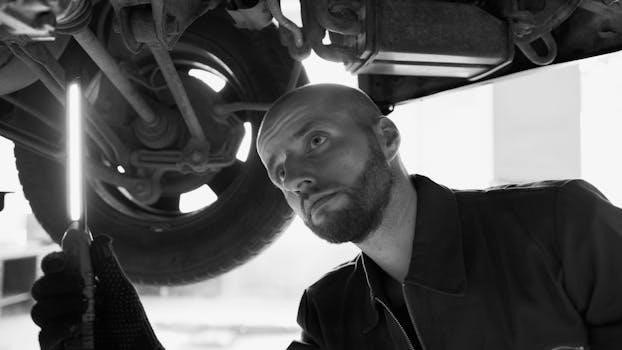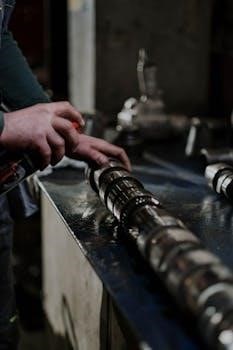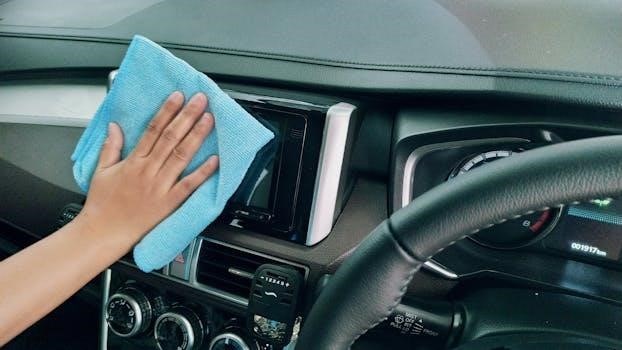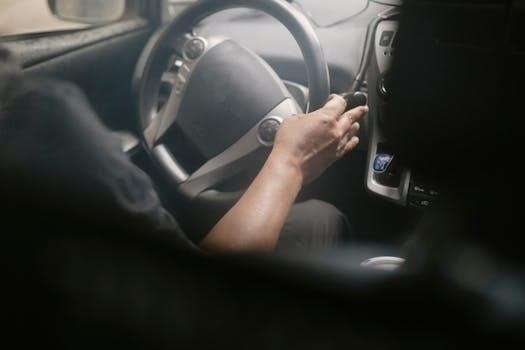1080p car DVRs have become essential for drivers‚ offering high-definition recording for enhanced clarity. These devices capture crucial details while driving‚ ensuring a reliable record of any incidents.
Importance of User Manuals
User manuals for 1080p car DVRs are paramount for optimal device operation and longevity. These manuals provide essential guidance on how to correctly set up‚ use‚ and maintain your car DVR‚ ensuring you can leverage all its features effectively. A thorough understanding of the manual helps users to avoid common pitfalls and ensures correct configuration of the device. Improper use can lead to issues such as recording failures or incorrect settings that may compromise the device’s functionality. Following the instructions on initial setup‚ navigation of menus‚ and correct operation of control buttons will save you time and prevent frustration. Moreover‚ the manual contains important information about the device’s technical specifications‚ troubleshooting advice‚ and safety precautions which are essential for a smooth and safe user experience. Detailed instructions on mounting‚ charging‚ and optimal positioning‚ as well as the loop recording and G-sensor functionality‚ will significantly enhance your use of the device. So please‚ always read your user manual carefully.

Key Features of 1080p Car DVRs
1080p car DVRs boast features like Full HD recording‚ wide-angle lenses‚ loop recording‚ G-sensors‚ and parking mode. These key aspects ensure comprehensive and reliable recording of your journeys.
1080p Full HD Recording Quality
The cornerstone of a 1080p car DVR is its ability to capture video in full high definition. This feature ensures that recordings are sharp‚ clear‚ and detailed‚ providing a significant advantage when reviewing footage of any incident. The 1920 x 1080 resolution allows for easy identification of license plates‚ road signs‚ and other crucial elements. With full HD‚ the video recordings show a high level of color accuracy and detail‚ enhancing the reliability of the video documentation. This recording quality is important because it can make the difference between a clear understanding of an event and a blurry‚ unclear recording. The enhanced details in the footage are also important in situations where the recording might be used in insurance claims or legal proceedings‚ providing an accurate and reliable record. Therefore‚ 1080p Full HD recording is important for any car DVR.
Wide Angle Lens and Viewing Angles
A wide-angle lens is a crucial component of a 1080p car DVR‚ allowing it to capture a broader view of the road ahead. Typical viewing angles range from 120 to 170 degrees‚ ensuring that more of the surrounding environment is recorded‚ including adjacent lanes and sidewalks. This wider field of view minimizes blind spots‚ which is extremely important for capturing all the details of an accident. The wide viewing angle also means that events happening on the periphery of the vehicle’s path are not missed. This is especially useful for recording side-impact collisions or incidents involving other road users. The wide-angle lens ensures a comprehensive picture of the road‚ providing a more complete and valuable record for any situation that might require review. The wide-angle lens gives the car DVR a broader perspective‚ resulting in a more reliable video record.
Loop Recording Functionality
Loop recording is an essential feature found in most 1080p car DVRs‚ designed to ensure continuous recording without the need for manual file management. This function automatically overwrites the oldest video files when the memory card is full‚ allowing the DVR to constantly record new footage. The loop recording feature typically offers various recording intervals‚ such as 1‚ 2‚ 3‚ or 5-minute segments‚ giving users some control over file size and management. This seamless cycle loop recording guarantees that the car DVR is always capturing the most recent footage‚ making it particularly useful in the event of an incident. The loop recording feature eliminates the need to manually delete old files to free up storage space‚ which provides smooth‚ worry-free operation. This is a very important function for the user.
G-Sensor and Impact Detection
The G-Sensor‚ also known as an accelerometer‚ is a critical component in 1080p car DVRs‚ designed for impact detection. This sensor automatically detects any sudden or significant changes in the car’s movement‚ such as during a collision or hard braking. When an impact is detected‚ the G-Sensor triggers the DVR to automatically lock and save the current video file‚ preventing it from being overwritten by the loop recording function. This ensures that crucial footage of the incident is preserved for future review. The sensitivity of the G-Sensor can often be adjusted in the DVR’s settings to suit individual preferences or driving conditions‚ making it a practical safety feature. This is an essential feature.
Parking Mode Operation
Parking mode is a valuable feature in 1080p car DVRs‚ designed to provide surveillance even when your vehicle is parked and unattended. This mode uses the DVR’s G-sensor to detect any impact or motion‚ automatically triggering the recording process. The DVR will start recording if it detects any bumps or movements around the vehicle. This functionality is particularly useful in cases of parking collisions or vandalism‚ as it captures the events that occur while you are away. The recording will typically stop after a set period‚ or when the car’s battery voltage drops to a certain level‚ to prevent battery drain. Some advanced parking modes may also use motion detection‚ where it starts recording when movement is detected within the camera’s view.

Basic Operation and Controls
Understanding the basic operation and controls of your 1080p car DVR is crucial for effective use. This section covers power‚ menu navigation‚ and button functions.
Power and Control Buttons
The power button on your 1080p car DVR is typically used for turning the device on and off. A short press may activate the screen or start recording‚ while a longer press might fully shut down the device. Some models may have an “OK” or “Record” button‚ which is used to start and stop recording. The “Up” button often zooms out in recording mode and navigates up in menus. The “Down” button may zoom in‚ and navigates down in menus. A “Menu” button allows access to the various settings. A lock button may be present to protect the current video recording from being overwritten. Be familiar with your specific model’s control layout as button functions can vary slightly. The power port will always be available to connect the device to power from the car lighter.
Menu Navigation and Settings
Navigating the menu of a 1080p car DVR is usually done using the “Menu” or “Mode” button‚ which takes you to the main menu screen. From there‚ you can use the “Up” and “Down” buttons to scroll through the different options. Pressing “OK” or a similar button selects an option and enters its submenu. Settings typically include video resolution (1080p‚ 720p‚ etc.)‚ loop recording duration (1‚ 2‚ 3‚ or 5 minutes)‚ G-sensor sensitivity‚ date and time settings‚ and parking mode options. Other settings such as exposure‚ HDR‚ and language can also be adjusted. It is important to explore the menu options thoroughly to customize the DVR to your specific needs. Always refer to your specific model’s user manual for exact menu navigation.

Installation and Setup
Proper installation of your 1080p car DVR is crucial for optimal performance. This involves securely mounting the device and correctly setting it up for the first use;
Mounting and Positioning
When mounting your 1080p car DVR‚ careful consideration of its placement is vital for optimal performance. The device should be positioned in a location that provides a clear‚ unobstructed view of the road ahead‚ avoiding any areas that might be obscured by the vehicle’s frame or other components. Typically‚ the best location is near the rearview mirror or on the dashboard‚ ensuring that the camera lens has a wide field of view. It is important to check local laws regarding the placement of such devices‚ as some areas have specific regulations. Before permanently affixing the mount‚ it is advised to test the camera’s view from the chosen spot to confirm the quality of the recording and ensure that it captures all necessary details. Avoid mounting the DVR in a position where it could interfere with the driver’s visibility or the deployment of airbags‚ as safety should always be the primary concern. Using the provided suction cup or adhesive mount‚ ensure that the device is firmly attached to the windshield or dashboard‚ preventing any movement or vibration while driving. Once mounted‚ double-check the stability of the DVR to ensure it will remain in place during regular use and in case of minor bumps.
Initial Setup and Charging
Before using your 1080p car DVR‚ it is essential to complete the initial setup and charging process. Begin by connecting the device to the included car charger using the mini USB interface. This step ensures that your DVR has sufficient power to operate correctly. It’s recommended to charge the device for at least four hours prior to its first use‚ allowing the battery to reach its full capacity. This initial charge will help maximize the lifespan of the device’s battery and ensure consistent performance during operation. While charging‚ you might want to familiarize yourself with the DVR’s basic functions and menus. Once charged‚ insert a micro SD card into the device’s designated slot; be certain it is supported by the device‚ often up to 64GB. Without the SD card‚ the DVR will not be able to record footage. After these steps‚ turn on the device and navigate through the menu to set the date‚ time‚ and other relevant parameters. This will ensure that your recordings are accurately timestamped. Finally‚ make a test recording to confirm that the DVR is operating as it should before you take it on the road.

Troubleshooting and Maintenance
Proper maintenance of your 1080p car DVR is important. If any issues arise‚ consult the user manual for solutions. Regularly clean the lens‚ and check connections for optimal performance.
Common Issues and Solutions
Users of 1080p car DVRs may encounter various issues that can affect their device’s performance. One common problem is the device not powering on‚ which can often be resolved by ensuring the car charger is properly connected and that the device has sufficient charge. Another frequent issue is recording quality being poor‚ which might be due to a dirty lens or incorrect settings. If the recording is choppy or skips‚ try formatting the memory card or using a higher-quality one. Loop recording problems can occur if the memory card is full or is not configured correctly. Check the settings for loop recording duration and make sure the device has the right capacity memory card. If the device is showing error messages‚ referring to the user manual can be helpful. It is also necessary to make sure that the device is not exposed to extreme temperatures or direct sunlight for extended periods‚ as it can cause malfunctions. Always ensure you are using the recommended power adapter to avoid power-related issues. Finally‚ for any persistent issues‚ consult the manufacturer’s support resources or contact their customer service.
